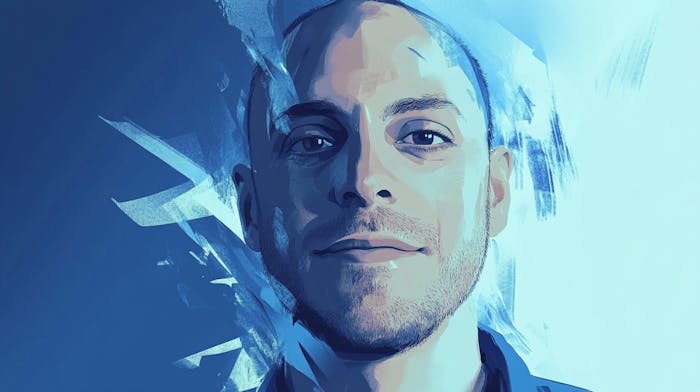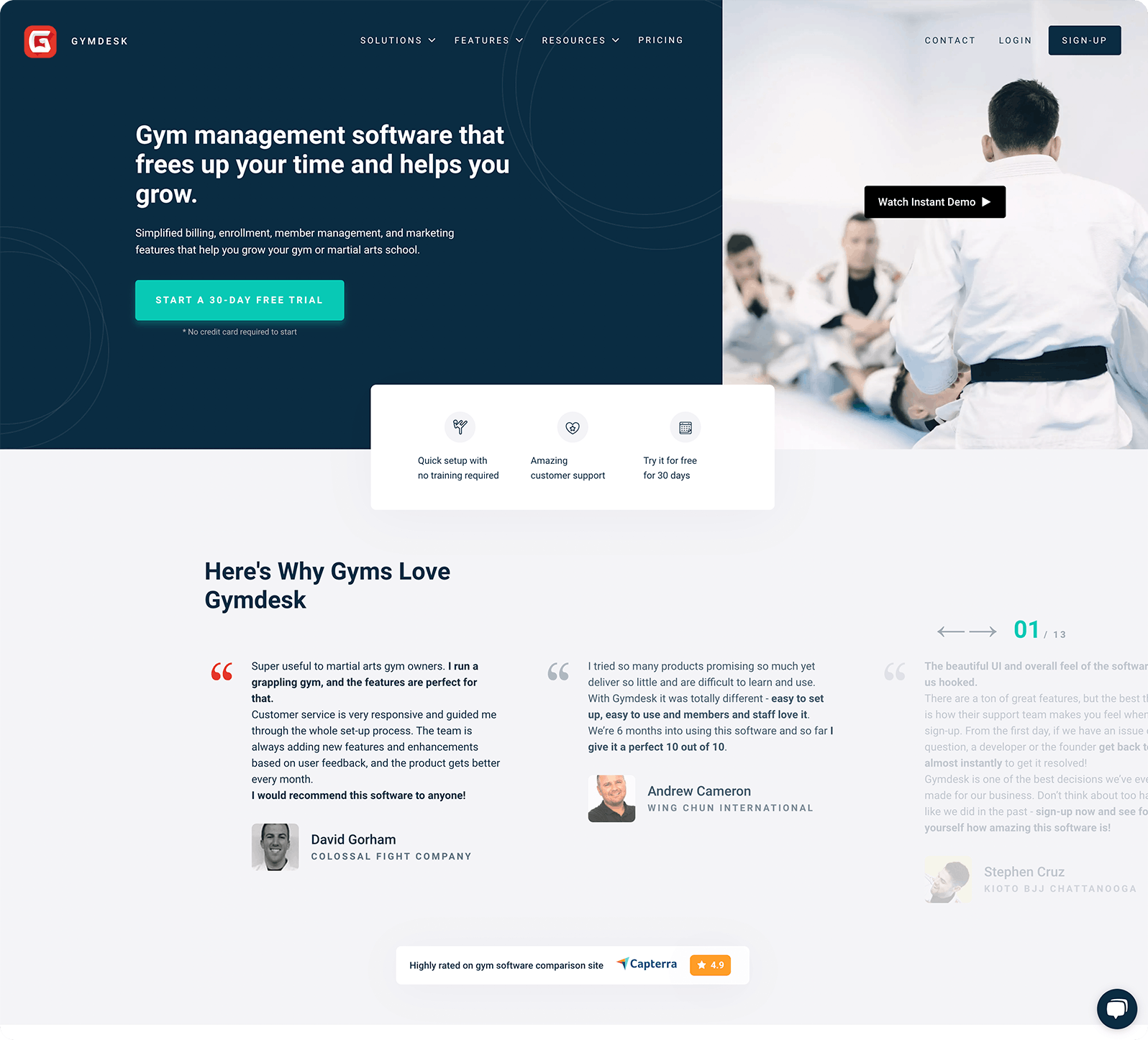Exiting his first B2B SaaS for a life-changing
$32.5M

Eran Galperin recently sold his first B2B SaaS, Gymdesk, for $32.5M. It was making $2.9M ARR at the time.
The process of growing and exiting wasn't easy.
Here's Eran on how he did it. 👇
Getting into the B2B SaaS game
I studied physics in university, and expanded from there to working as a freelance developer, eventually starting several tech companies. I've been building products for close to 20 years.
The most recent one is a B2B SaaS company I started in 2016 called Gymdesk, which provides management software to gyms and other fitness and wellness businesses.
When I started Gymdesk, I was at an inflection point in my career, having just wound down a VC company I cofounded back in 2010. The company raised a seed round, but eventually didn’t grow sufficiently to hit its benchmarks and continue raising, which is the normal VC track.
I wanted to try something different this time by going bootstrapped. And I wanted to focus on the business model that appealed to me the most: B2B SaaS.
I considered several verticals, but kept coming back to doing something related to a personal hobby of mine. I’ve been training seriously in Brazilian Jiu-Jitsu since 2006 and wanted to combine that with my professional work. In fact, it was originally called "Martial Arts on Rails”, targeting just martial arts schools. But we eventually expanded to include other similar use cases such as gyms, yoga studios, gymnastics gyms, and more.

Using a familiar stack
Being a technical founder and a full stack developer, I had high confidence that I could put up an initial version of the product myself. I spent around $3k on the initial design and put it up on a dedicated server on Digital Ocean.
Gymdesk is built on a LNMP (Linux/Nginx/MySQL/PHP) running on the Zend Framework. jQuery and vanilla JS on the front end.
This is a stack I’m very familiar with and had strong scaffolding already from previous projects, which allowed me to continue to iterate quickly and with no external resources.
Even now, almost nine years later, the product still runs on a single dedicated server instance, though we will be adding more redundancy/failover soon. Our hosting bill is around $400 at this point.
Bootstrapping to product-market fit
It took me about four months, all-in, to launch the product in April 2016. From there, it took me three to four months to realize that I had no idea how to acquire customers.
In order to support myself while the product was getting off the ground, I took up some contract work as a developer and, eventually, a CTO role in a DTC e-commerce company, which I left in 2019 once Gymdesk was generating more revenue than my full-time salary.
During that time, I developed a fine-grained flow for ingesting customer feedback and rolling it back into the product. I was working on it during the weekends, constantly refining and expanding the scope of what the product could do.
It was only around the beginning of 2020 that we hit product-market fit and started seeing significant growth. We went from $12k MRR at the beginning of the year to ~$20k by the end of the year, despite COVID.
Sell when you don't need to
Gymdesk hit $2.9M in ARR at the end of 2023, at which point I started having conversations with private equity firms regarding a potential acquisition. I completed a majority equity financing of the company in May this year for $32.5M.
I never imagined I would sell the business when I started, and definitely not for a life-changing amount. What I learned is the best time to sell a business is when you don’t need to.
We had strong fundamentals — low churn and solid growth, as well as strong customer satisfaction. Those factors, in addition to the revenue milestone we hit, allowed us to command a strong multiple in the market.
Work on your fundamentals
My first advice would be to work on your business fundamentals if you want to have a potential exit. The better the business is, the better the deals you will get for it.
Separate yourself from your business
Secondly, start separating yourself from the business — enough that you could potentially walk away if you wanted to. This is a process that I started two years before the actual sale, when I started receiving inbound interest in the company.
Find a broker firm
And lastly, as you are considering a possible sale, engaging a good sell-side broker firm would be extremely beneficial if it’s your first time selling. That, and an M&A lawyer who has experience in your type of business. Those two will be your main support pillars during the process.
I wrote about the sale process in detail on my blog — it’s highly technical and involved, so take a look if it’s something you are considering.
Growing via SEO
The first few customers of the product were people I knew personally in the industry, however, once I ran through my contact list, I struggled acquiring customers. The main problem was visibility. I had no idea how to get in front of potential customers.
I tried doing some outreach and guest blogging for a while, with basically no results. Initially, the only thing that worked — to an extent — was a small PPC ad spend on a software comparison website called Capterra and its sister sites, GetApp and Software Advice.
But I continued to invest in content and SEO, as that was the channel I was most familiar with and, over time, it grew to become our main acquisition channel, with over 60% of our leads coming from there thanks to good search intent.
Figuring out SEO for SaaS was a slow and grueling process, but once it started working it was a very good match for the PLG/self-service model of our product.
Over time, we continued to develop additional channels for customer acquisition, including integration and marketing partnerships, referrals, and resellers.
Don't outsource customer acquisition
That's all well and good, but it took me about four years to start figuring out customer acquisition, and two more years to actually get good at it.
I initially made the mistake of trying to outsource marketing and sales to external agencies and contractors. What I learned was that those mostly try to apply a standard playbook without a nuanced understanding of your business and audience.
I now firmly believe that the founder should figure out marketing to the point that they understand it enough to be able to outsource some aspects of it effectively.
Iterate on pricing
Gymdesk is a traditional recurring subscription SaaS - our users pay us a monthly subscription that scales in steps with the size of their account. Price is dependent on the number of members and locations each account has.
We restructured our pricing plans in 2022, and that caused a significant increase in our revenue growth. Most founders get pricing wrong and tend to avoid touching it for fear of upsetting their customers. We definitely did that for a long time, and are still not fully optimal there.
In addition, we generate significant additional revenue from our payment volume, via revenue share agreements with our payment partners such as Stripe and Square. It took me a while to understand the inherent value in the processing volume that goes through our platform, and it’s something I would recommend any product that processes payments to take a strong look at.
Focus on product and satisfaction
There are two main things that helped us be successful over the years, and which compose the DNA of the company: Focus on the product and customer satisfaction.
There are 2 ways to address customer feedback about the product:
Invest in support resources, such as documentation, support reps, training, etc.
Invest in the product to make things simpler and easier to understand.
I heavily optimized for the latter in the formative years of the company, as it was more in my wheelhouse, and over time, I became a very strong product person.
Since then, we’ve also invested significantly in our support infrastructure, as there’s a limit to how much you can scale it with just one person. This obsession with customer satisfaction is what propelled us to where we are today.
Grow into your weaknesses
There are so many things to do when you’re starting out and you’re the only operator. You have to do two things:
Learn how to prioritize effectively.
Do the things you are not good at until you get good at them. That's what I had to do with marketing.
The toughest stretch is the first two to three years when money is tight and there are fires to put out every week. A lot of becoming successful is to have the perseverance to gut out that period, and to continuously learn from your mistakes to operate more efficiently and effectively.
A book I would highly recommend specifically for indies building a B2B SaaS product is The SaaS Playbook by Rob Walling. It is full of tactical advice every B2B SaaS should consider for building a successful company.
What's next?
After selling a majority stake of the company to PE, I still have rollover equity in the company and am excited to see it continue to grow post-sale.
This stage, typically referred to as the “scale-up” stage, is very interesting to me, from recruiting the executive team to building frameworks and structure in the company to building a sales machine to take it to the next level.
On the personal side, I’ve started to angel invest and mentor early-stage B2B SaaS companies, which has been going really well and is very rewarding for me personally.
I write about bootstrapping and growing B2B SaaS on my website, so check it out if those topics are of interest to you. You also find me on LinkedIn and X.

Leave a Comment
Truly inspirational stuff! I'm just starting out with my product launching soon, but it's such a daunting prospect! Stories like this fill me with hope. Well done :)
Truly impressive stuff!
How did you crack SEO?
Truly impressive !
Such an inspiring story!
Congratulations man!!! and excellent advice especially with the marketing element. I think technical founders often struggle in that part.
Congrats man!